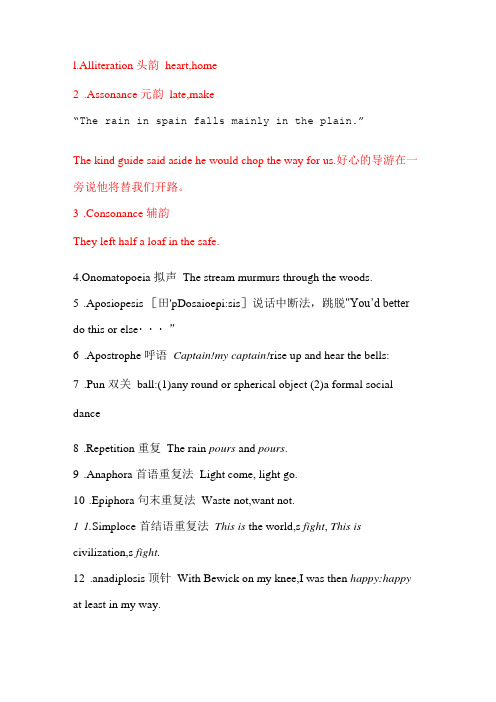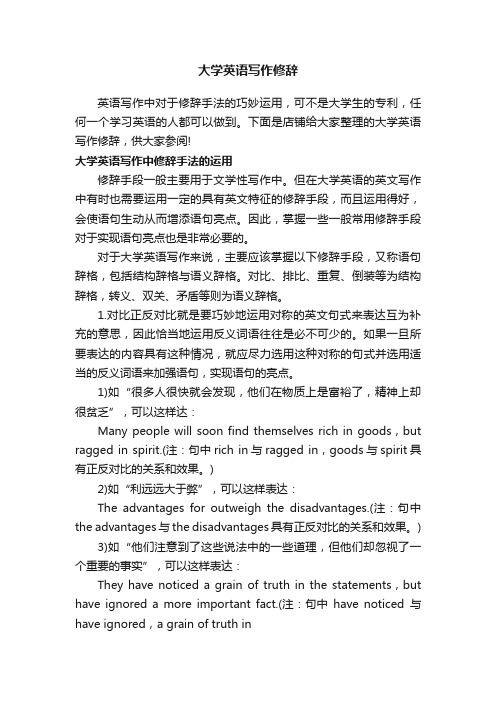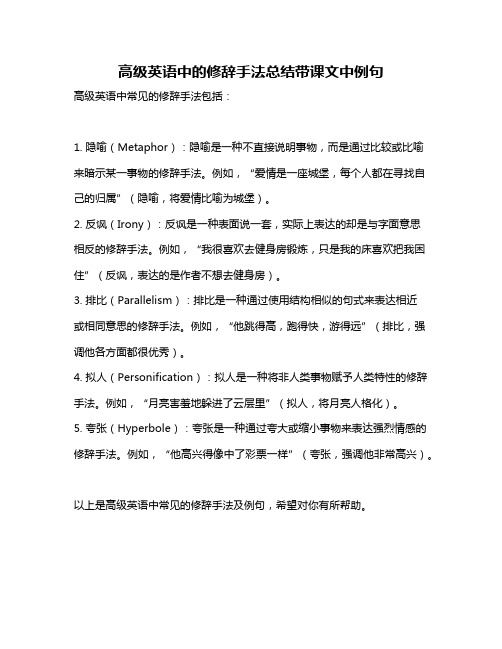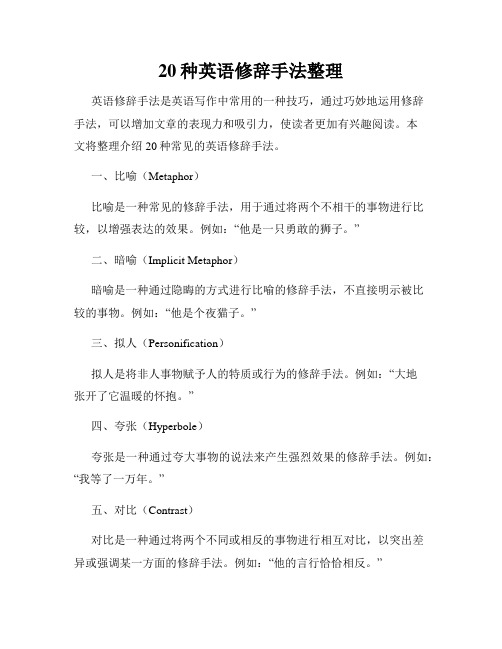英语中的修辞大三
大学英语英语修辞简介2

1)Nominal metaphor
Eg: 1. Time is money.
2. The news is a dagger to his heart.
2)Verbal metaphor
Eg: 1.The electricity failure paralyzed the train service.
1. Simile(明喻)
Definition: A figure of speech in which one thing is likened to another, in such a way as to clarify and enhance an image.
(In dealing with simile, an additional point should be noted: the two things compared are in different kinds and are said to be similar in one respect only, and not in all ways.)
2. He treats his daughter as the apple in the eye.
3. Samuel Johnson regarded a dictionary as a watch.
2. Metaphor(暗喻)
Definition: A figure of speech containing an implied comparison, in which a word or phrase ordinarily and primarily used one thing is applied to anther.
大学英语修辞整理及例子

l.Alliteration 头韵heart,home2.Assonance 元韵late,make“The rain in spain falls mainly in the plain.”The kind guide said aside he would chop the way for us.好心的导游在一旁说他将替我们开路。
3.Consonance 辅韵They left half a loaf in the safe.4.Onomatopoeia 拟声The stream murmurs through the woods.5.Aposiopesis [田'pDosaioepi:sis]说话中断法,跳脱"You’d better do this or else・・・”6.Apostrophe 呼语Captain!my captain!rise up and hear the bells:7.Pun 双关ball:(1)any round or spherical object (2)a formal social dance8.Repetition 重复The rain pours and pours.9.Anaphora 首语重复法Light come, light go.10.Epiphora 句末重复法Waste not,want not.11.Simploce 首结语重复法This is the world,s fight, This is civilization,s fight.12.anadiplosis 顶针With Bewick on my knee,I was then happy:happy at least in my way.13.Parallelism 平行结构The young actor was tall,dark,and handsome.14.Antithesis 对偶Marriage is easyjhousekeepin g is hard.15.Climax 层进法We want peace,we want freedom,we want a better life.16.Anticlimax 突降法Where shall I find hope, happiness friends, cigarettes?17.Syllepsis 一语双叙He lost his coat and his temper.18. Zeugma 轭式修辞法We ate a bun and a glass of milk.19. Chiasmus 回文One should eat to live,not live to eat.20.Asyndeton 连词省略法Nothing is insider them, they were sealed up before the creation of pestilence.21.Polysyndeton 连词叠用法I am a soul, or a body, a mind.22.Rhetorical question 反问Isn’t it the best choice?23.Simile 明喻Time flies like an arrow.24.Metaphor 暗喻You are my sunshine.25.Metonymy 借喻He has a good ear for music.26.Synecdoche 提喻He paid the workers $5 per head.27.Antonomasia换称He is modern Hitler---a tyrant.Jack is Michael Jordan on our basketball team.28.Personification 拟人The bird is singing joyfully.29.Parody 仿拟I had no outlook,but an uplook rather.30.Synesthesia 通感The music breathing from her face.31.Transferred epithet 移情a sleepless bed32.. understatement轻描淡写,低调陈述1.AUTHOR &WORKS1>William Faulkner is the author of.A.Far From the Madding CrowdB. Sound and FuryC. For Whom the Bell TollsD. Scarlet LetterKey B2>The Old Man and the Sea is one of the great works by.A. Jack LondonB. Charles DickensC. Samuel ColeridgeD. Ernest HemingwayKey: D3>James Joyce is the author of all the following novels EXCEPT.A. DublinersB. A Portrait of the Artist as a Young ManC. Jude the ObscureD. UlyssesKey: C4>Which of the following is NOT a poem by Emily Dickinson?A. This is my letter to the world.B. / heard a fly buzz —when I died.C. This is just to say.D. Because I could not stop for death.Key: C (William Carlos Williams)5>Francis Bacon' s is a great essay on education.A. The Advancement of LearningB.The Importance of Being EarnestC.The New AtlanticD.The Learned Reading upon the Statute of UsesKey: A6>William Makepeace Thackeray' s most famous work is.A. The School for ScandalB. Past and PresentC. Major BarbaraD. Vanity FairKey: D7>Which of the following poems is NOT written by George Gordon Byron?A.She Walks in Beauty.B.The Solitary Reaper.C.When We Two Parted.D.Childe Harold' s Pilgrimage.Key: B8> William Golding' s first and most well-known novel is.A. Coral IslandB. Lord of the FliesC. Treasure IslandD. The Brass ButterflyKey: B9> Moby Dick is the most important work by.A. Jack LondonB. Herman MelvilleC. Sinclair LewisD. Ralph EllisonKey: B10>Stephen Crane is famous for.A. An American TragedyB. The AmbassadorsC. Main StreetD. The Red Badge of CourageKey: D11>Robert Frost is a famous.A. novelistB. playwrightC. poetD. literary criticKey: C12>Eugene 0' Neil is an American.A. novelistB. playwrightC. poetD. essayist KEY:B 13>is considered to be the best-known English dramatist since Shakespeare, and his representative works are plays inspired by social criticism.A. Richard SheridanB. Oliver GoldsmithC. Oscar WildeD. Bernard ShawKEY:D14>Who is the only woman writer that has won both Pulitzer Prize and Nobel Prize?A. Pearl Buck.B. Virginia Woolf.C. Tony Morrison.D. Katharine Mansfield.KEY: A15>is NOT among the postwar poets in modem American literature.A. Robert LowellB. Gary SynderC. Alien GinsbergD. e. e. cummingsKEY: D16>Shylock is a character in.A. The Merchant of VeniceB. The Twelfth NightC. The Winter's TaleD. MacbethKEY: A17>This line "If Winter comes, can Spring be far behind?' is quoted fromA. Don Juan.B. Kubla KhanC. To AutumnD. Ode to the West Wind KEY: D18>The sentence "Shall I compare thee to a summer' s day" is quoted from Shakespeare' s.A. comediesB. tragediesC. historiesD. sonnetsKEY : D19>"Beauty is truth, truth beauty" is an epigrammatic line by.A. John KeatsB. William BlakeC. William WordsworthD. Percy Bysshe ShelleyKEY: A19>"Beauty is truth, truth beauty" is an epigrammatic line by.A. John KeatsB. William BlakeC. William WordsworthD. Percy Bysshe Shelley KEY: A20>Tess is a character created by.A. D. H. LawrenceB. James JoyceC. Thomas HardyD. Dylan Thomas Key: C21>As a literary figure, Heathcliff appears in.A. Jane EyreB. Oliver TwistC. Wuthering HeightsD. Middlemarch Key: C22>Emily Grierson is a literary figure created by.A. Willa GatherB. Doris LessingC. William FaulknerD. Nathaniel Hawthorn Key: C 23> Mr. Micawber in David Copperfield and Sam Well in Pickwick Papers are perhaps the best characters created by CharlesDickens.A. comicB. tragicC. roundD. sophisticated Key: A24> Mr. Darcy is a character in.A. Tess of the D' UrhervillesB. Pride and PrejudiceC. Happy PrinceD. The Mill on the Floss Key: B25> The image of the famous "henpecked husband" is created by. A. Washington Irving B. Fennimore CooperC. Edith WhartonD. William Dean Howells Key: A 26>is a popular literary form in the medieval period.A. RomanceB. NovelC. SonnetD. Drama Key: A27>was the most important person of the transcendental club.A.HawthornB. WhitmanC. EmersonD. Thoreau Key: C28> The literary spokesman of the Jazz is often thought to beA. O'NeilB. PoundC. Robert FrostD. Scott Fitzgerald Key: D29>Together with Lawrence and Joyce,is considered one of the three giants of the modern English novel and a master of English prose. A. Henry James B. Joseph ConradC. E. M. ForsterD. Aldous Huxley Key: B30>,the author of The Interpretation of Dreams has great impact on literary creation and criticism.A. Carl JungB. Jean-Paul SartreC. Friedrich Wilhelm NietzscheD. Sigmund Freud Key: D 31> Which of the following is NOT a typical feature of Modernism? A.To elevate the individual and inner being over the social being.B.To put the stress on traditional values.C.To portray the distorted and alienated relationships between man and his environment.D.To advocate a conscious break with the past. Key: B32>Whitman's poems are characterized by all the following features EXCEPT.A. a strict poetic formB. a simple and conversational languageC.a free and natural rhythmic patternD. an easy flow of feelings Key: A33> Who initiated the name of the Lost Generation?A. Hemingway.B. Fitzgerald.C. Gertrude Stein.D. William Faulkner. Key: C34> The high tide of Romanticism in American literature occurred aroundA. 1820B. 1850C. 1880D. 1920 Key: A35> The success of Jane Eyre is partly due to its introduction to the English novel the first heroine.A. explorerB. peasantC. workerD. governess Key: D 36>is the representative work of the Beat Generation.A. The Great GatsbyB. On the RoadC. Look Back in AngerD. The Sun Also Rises Key: B 37>The most significant idea of the Renaissance is.A. humanismB. realismC. naturalismD. skepticism Key: A 38>The title of Thackeray's "Vanity Fair" is taken from —A. The Holy BibleB. The Faerie QueenC.The Pilgrim's ProgressD. Paradise Lost Key: C39>Who is considered the father of American poetry?A. Philip Freneau.B. William Cullen Bryant.C. Henry Wadsworth Longfellow.D. Henry David Thoreau.Key: A ( The Wild Honey Suckle)40>Iceberg Theory is a writing principle proposed and closely followed by.A. Jack LondonB. Sinclair LewisC. William FaulknerD. Earnest Hemingway Key: D41>is featured by black humor.A. CaricatureB. Catch-22C. The Catcher in the RyeD. Death of a Salesman Key: B 42>has won the Pulitzer Prize four times and Nobel Prize.A. Ernest HemingwayB. John SteinbeckC. Eugene 0' NeilD. William Faulkner Key: C43>is known as "the poet' s poet".A. ShakespeareB. MarloweC. SpenserD. Donne Key: C44> Robert Burns is a poet from.A. EnglandB. New EnglandC. IrelandD. Scotland Key: D45>Generally, the Renaissance refers to the period between and centuries.A. 14th/mid-17thB. 14th/mid-18thC. 16th/mid-18thD. 16th/mid-17th Key: A46>O Captain! My Captain! was written in memory of.A. Walt WhitmanB. Benjamin FranklinC. Abraham LincolnD. Martin Luther King Key: C47>The first book of the Old Testament is called.A. ExodusB. NumbersC. LeviticusD. Genesis Key: D 48>WilliamBlake' s The Tiger is collected in.A. Songs of InnocenceB. Songs of ExperienceC. Marriage of Heaven and HellD. Poetical Sketches Key: B 49>Who is the father of English poetry?A. Shakespeare.B. Edmund Spencer.C. John Milton.D. Geoffrey Chaucer. Key: D50>The 1954 Nobel Prize for literature was awarded to for his "mastery of the art of modem narration".A.William FaulknerB. John SteinbeckC. Saul BellowD. Ernest Hemingway Key: D51>It is generally regarded that Keats' s most important and mature poems are in the form of.A. odeB. elegyC. epicD. sonnet Key: A52> 0. Henry earned his fame mainly for his.A. novelsB. poemsC. short storiesD. dramas Key: C 53> Works by are characterized by stream-of-consciousness.A. George EliotB. Jane AustenC. Emily BronteD. Virginia Woolf Key: D54>Who of the followings is a playwright of the "theater of absurd" ?A.John Osborn.B. Wystan Hugh Auden.C. Bernard Shaw.D. Samuel Beckett. Key: D55>In the works of such aesthetics, as and Walter Pater, thetheory of "art for art' s sake" is advocated.A. Oscar WildeB. Mrs. GaskellC. Alexander PopeD. Charles Lamb Key: A56>The Romantic Age in England came to an end with the death of .A. Jane AustinB. Walter ScottC.Samuel Taylor ColeridgeD. William Wordsworth Key: B 57>The Victorian Age was largely an age of, eminently represented by Dickens and Thackeray.A. pessimismB. naturalismC. modernismD. critical realism Key: D58>In which novel can "Yahoo" be found?A. John Bunyan' s Pilgrim' s Progress.B.Edmund Spencer' s The Faerie Queen.C. Jonathan Swift's Gulliver's Travels.D.Henry Fielding' s Tom Jones.Key: C (Lilliput, Brobdingnag, Laputa, Yahoo)59>The Bronte Sisters published the following famous novels EXCEPTA. The Tenant of Wildfell HallB. Jane EyreC. Wuthering HeightsD. Agnes Grey Key: A 60>Beowulf narrates a story taking place in.A. the MediterraneanB. Northern EuropeC. EnglandD. Scandinavia Key: D1.The national epic of the Anglo-Saxons is.A . Robin Hood B. Sir Gawain and the Green KnightC. The Canterbury TalesD. Beowulf2.was the most outstanding single romance on the Arthurian legend written in alliterative verse.A. The Canterbury TalesB. Piers the PlowmanC. Sir Gawain and the Green KnightD. Beowulf3. Most of the ballads of the 5 th century focused on the legend aboutas a heroic figure.A. Green NightsB. GawainC. Robin HoodD. Hamlet4.In the 16th century, Thomas More' s work became immediately popular after its publication.A. Paradise LostB. A Pleasant Satire of the Three EstatesC. Of BeautyD. Utopia5.was Edmund Spencer' s masterpiece which has been regarded as one of the great poems in the English language.A. AmorettiB. The Shepherd' s CalendarC. The Faerie QueenD. Four Hymns6.is from Shakespeare' s sonnet No.18.A.Let me not to the marriage of true mindsB.“To be or not to be: that is the question”C.“ Shall I compare thee to a summer' s day”D.“No longer mourn for me when I am dead”7.The vivid portrayal of by Shakespeare in Henry IV has earned for him an enviable place in the history of English literature.A . Julius Caesar B. Falstaff C. Hamlet D. King Henry 8.The four great tragedies written by Shakespeare are Hamlet, Macbeth, Othello and. A. Antony and Cleopatra B. Julius CaesarC. Twelfth NightD. King Lear9.Which of the following does not belong to Shakespeare' s romantic love comedies?A. Twelfth NightB. The TempestC. As You Like ItD. The Merchant of Venice10.The hero who has fallen a victim to his own ambition must be.1.Hamlet B. Othello C. King Lear D. Macbeth 11.is acclaimed as “the poets ' poet” ,A. ShakespeareB. SpenserC. KeatsD. Chaucer 12. The allusion “A Pound of Flesh” comes from Shakespeare ' sA. HamletB. The Merchant of VeniceC. King LearD. Othello13.At the turn of the 18th and 19th centuries appeared in Englandas a new trend in literature.A. RenaissanceB. ReformationC. RomanticismD. Sentimentalism14.Of studies was written by.A. John Bunyan.B. John Donne.C. Francis Bacon.D. William Blake.15.Which of the following is the highest form of literary expression?A. Prose.B. Poetry.C. Novel.D. Speech.16.The 18th century in English literature is an age of.A. novelB. poemC. proseD. play17.Which of the following work tells how Satan rebelled against God and how Adam and Eve were driven out of Eden?A. Paradise LostB. Paradise Regained.C. L' ALLegro.D. Lycidas.18.Who is the creator and a great master of the historical novel?A. John Keats.B. Walter Scott.C. Jane Austen.D. Charles Lamb.19.Bunyan 's most important work is, written in the old-fashioned, medieval form of allegory and dream.A. The FootprintB. On His BlindnessC. Vanity FairD. The Pilgrim's Progress20.Romanticism as a literary movement came into being in England early in the latter half the century.A. 16thB. 17thC. 18thD. 19th21.The novel Oliver Twist was written by.A. Jane AustenB. John Keats C . Charles Dickens D. George Eliot 22.In Anglo-Saxon period, “Beowulf” represented the poetry.A. paganB. religionsC. romanticD. sentimental 23. The epoch of Renaissance witnessed a particular development of English drama. It was who made blank verse the principal vehicleof expression in drama.A. Christopher MarloweB. Thomas LodgeC. Edmund SpenserD. Thomas More24.At the beginning of the 16th century the outstanding humanist wrote his Utopia in which he gave a profound and truthful picture of the people 's suffering and put forward his ideal of a future happy society.A. Thomas MoreB. Thomas MarloweC. Francis BaconD. William Shakespeare25.Of the following plays is not a comedy.A. A Midsummer Night 's DreamB. The Merchant of VeniceC. Twelfth NightD. Romeo and Juliet26.The first poem in The lyrical Ballads is Coleridge 's masterpieceA. Kubla KhanB. The PreludeC. The Rime of Ancient MarinerD. Tintern Abbey27.Dickens takes the French Revolution as the background of the novel.A. A Tale of Two CitiesB. Great ExpectationsC. Hard TimesD. David Copperfield28.Chaucer was the first important poet of a royal court to write in after the Norman Conquest.A. FrenchB. LatinC. EnglishD. Greek29.Beowulf was written in.A. Old EnglishB. Middle EnglishC. Early Modem EnglishD. French30. The English Renaissance period was an age of B. poetry and drama D. romance and poetry 6-10 C B D B D 16-20 C A B D C 26-30 C A C A B A. drama and novelC. novel and poetry1---5 D C C D C 11-15 B B C C B 21-25C A A A D。
大学英语修辞

大学英语修辞1) Simile:(明喻)2) Metaphor:(暗喻)3) Analogy: (类比)4) Personification: (拟人)5) Hyperbole: (夸张)6) Understatement: (含蓄陈述)7) Euphemism: (委婉)8) Metonymy (转喻)9) Synecdoche (提喻)10) Antonomasia (换称)11) Pun: (双关语)12) Syllepsis: (一语双叙)13) Zeugma: (轭式搭配)14) Irony: (反语)15) Innuendo: (暗讽)16) Sarcasm: (讽刺)17) Paradox: (隽语)18) Oxymoron: (矛盾修饰)19) Antithesis: (对照)20) Epigram: (警句)21) Climax: (渐进)22) Anti-climax or bathos: (突降)23) Apostrophe:(顿呼)24) Transferred Epithet: (一就修饰语)25) Alliteration: (头韵)26) Onomatopoeia: (拟声)修辞格(figures of speech)是提高语言表达效果的语言艺术。
它能使语言生动形象、具体活泼,给人以美的享受。
(一)音韵修辞格(phonological rhetorical devices)顾名思义,音韵修辞格是利用词语的语音特点创造出来的修辞手法。
包括: a) Onomatopoeia(拟声) 是模仿事物发出的声响,如:Presently there came theclick of high-heeled shoes.高跟皮鞋声咯咯地传了过来。
b) Alliteration(头韵) 就是在一个词组或一个诗行中,有两个以上彼此靠近的词,其开头的音节(或其他重读音节)具有同样的字母或声音;如:Peter Piper picked a peck of picking pepper.皮特.派特咽下了一口腌菜用的胡椒粉。
大学英语写作修辞

大学英语写作修辞英语写作中对于修辞手法的巧妙运用,可不是大学生的专利,任何一个学习英语的人都可以做到。
下面是店铺给大家整理的大学英语写作修辞,供大家参阅!大学英语写作中修辞手法的运用修辞手段一般主要用于文学性写作中。
但在大学英语的英文写作中有时也需要运用一定的具有英文特征的修辞手段,而且运用得好,会使语句生动从而增添语句亮点。
因此,掌握一些一般常用修辞手段对于实现语句亮点也是非常必要的。
对于大学英语写作来说,主要应该掌握以下修辞手段,又称语句辞格,包括结构辞格与语义辞格。
对比、排比、重复、倒装等为结构辞格,转义、双关、矛盾等则为语义辞格。
1.对比正反对比就是要巧妙地运用对称的英文句式来表达互为补充的意思,因此恰当地运用反义词语往往是必不可少的。
如果一旦所要表达的内容具有这种情况,就应尽力选用这种对称的句式并选用适当的反义词语来加强语句,实现语句的亮点。
1)如“很多人很快就会发现,他们在物质上是富裕了,精神上却很贫乏”,可以这样达:Many people will soon find themselves rich in goods,but ragged in spirit.(注:句中rich in与ragged in,goods与spirit具有正反对比的关系和效果。
)2)如“利远远大于弊”,可以这样表达:The advantages for outweigh the disadvantages.(注:句中the advantages与the disadvantages具有正反对比的关系和效果。
)3)如“他们注意到了这些说法中的一些道理,但他们却忽视了一个重要的事实”,可以这样表达:They have noticed a grain of truth in the statements,but have ignored a more important fact.(注:句中have noticed与have ignored,a grain of truth inthe statements与a more important fact具有正反对比的关系和效果。
浅谈英语中几种常见的修辞格

对于⼀个具有⼀定英语⽔平的⼈来说,谙熟其修辞⽅式,不仅有助于辨别该语⾔的各种修辞现象,了解修辞运⽤的规律,从⽽提⾼分析语⾔表现技巧的能⼒,⽽且还可以有⼒提⾼准确、有效地运⽤语⾔的能⼒。
为此,本⽂想就英语中⼏种常见的修辞格粗略地谈谈⾃⼰的看法。
⼀、⽐喻(the figures of speech) ⽐喻是语⾔艺术的升华,是最富有诗意的语⾔形式之⼀,是语⾔的信息功能和美学功能的有机结合。
英语中常见的⽐喻有三类:明喻、隐喻和转喻。
1.明喻(the simile) 明喻通常是把被⽐喻的“本体”和⽤以⽐喻的“喻体”同时说出,说明本体事物象喻体事物,⽤介词like ,连词as,as if,as…so,动词seem等以及句型A …to B as C…to D等等表⽰“好像”意思的⽐喻说法就叫明喻。
⼈们往往有这样的错觉,认为⽐喻修辞只适⽤于⽂学类的各种⽂体,⽽⾮⽂学类论著,如科技之类应⽤⽂体,为了表达的正确性、严密性与科学性,是排斥⽐喻的。
事实上,在英语的科技类的论著中,为了把描象的事物说得具体化、形象化,把深奥的道理说得通俗、浅显、明⽩,也经常使⽤⽐喻。
例如: (1)Bacteria are so small that a single round one of acommon type is about 1/25,000 of an in ch across when thesebacteria are magnified 1,000 times, they look only aslarge as apencil point. 细菌是这样⼩,⼀种普通类型的圆形细菌直径⼤约只有1/25,000英⼨。
这种细菌放⼤⼀千倍看起来也只有铅笔尖那么⼤。
(2)There now exists a kind of glass so sensitive to light that,like photographic film,it wil l record pictures and designs. 现在有⼀种对光⼗分敏感的玻璃,它像胶卷⼀样能记录图像和图案。
高级英语中的修辞手法总结带课文中例句

高级英语中的修辞手法总结带课文中例句
高级英语中常见的修辞手法包括:
1. 隐喻(Metaphor):隐喻是一种不直接说明事物,而是通过比较或比喻来暗示某一事物的修辞手法。
例如,“爱情是一座城堡,每个人都在寻找自己的归属”(隐喻,将爱情比喻为城堡)。
2. 反讽(Irony):反讽是一种表面说一套,实际上表达的却是与字面意思
相反的修辞手法。
例如,“我很喜欢去健身房锻炼,只是我的床喜欢把我困住”(反讽,表达的是作者不想去健身房)。
3. 排比(Parallelism):排比是一种通过使用结构相似的句式来表达相近
或相同意思的修辞手法。
例如,“他跳得高,跑得快,游得远”(排比,强调他各方面都很优秀)。
4. 拟人(Personification):拟人是一种将非人类事物赋予人类特性的修辞手法。
例如,“月亮害羞地躲进了云层里”(拟人,将月亮人格化)。
5. 夸张(Hyperbole):夸张是一种通过夸大或缩小事物来表达强烈情感的修辞手法。
例如,“他高兴得像中了彩票一样”(夸张,强调他非常高兴)。
以上是高级英语中常见的修辞手法及例句,希望对你有所帮助。
英语18种重要修辞手法

18种重要修辞手法一、语义修辞1明喻(simile)俗称直喻,是依据比喻和被比喻两种不同事物的相似关系而构成的修辞格。
例如:a figure of speech in which denotes a simmilarility betwe en things of different kinds.1.The snow was like a white blanket drawn over the field.2.He was like a cock who thought the sun had risen to hear him crow.认真观察以上各例,我们会发现它们的特点,由(as)... as, like等引导,这些引导词被称作比喻词(acknowledging word),它们是辨别明喻的最显著的特征,明喻较为直白,比喻物和被比喻物之间相似点较为明显,所以明喻是一种比较好判断的修辞手法。
2暗喻(metaphor)也称隐喻,是依据比喻和被比喻两种不同事物的相似或相关关系而构成的修辞格。
例如:a figure of speech in which refers to sth that denotes literally in order to suggest a similarity.1.His friend has become a thorn in his side.(他的朋友已变成眼中钉肉中刺。
)2.You are your mother’s glass.(你是你母亲的翻版。
)3.Hope is a good breakfast, but it’s a bad supper.由以上各例可知,暗喻没有引导词,这是明喻和暗喻在形式上的最大区别。
换句话说,有为明喻,没有为暗喻。
如:He has a heart of stone. He has a heart like stone.很显然,前句是暗喻,后句是明喻。
20种英语修辞手法整理

20种英语修辞手法整理英语修辞手法是英语写作中常用的一种技巧,通过巧妙地运用修辞手法,可以增加文章的表现力和吸引力,使读者更加有兴趣阅读。
本文将整理介绍20种常见的英语修辞手法。
一、比喻(Metaphor)比喻是一种常见的修辞手法,用于通过将两个不相干的事物进行比较,以增强表达的效果。
例如:“他是一只勇敢的狮子。
”二、暗喻(Implicit Metaphor)暗喻是一种通过隐晦的方式进行比喻的修辞手法,不直接明示被比较的事物。
例如:“他是个夜猫子。
”三、拟人(Personification)拟人是将非人事物赋予人的特质或行为的修辞手法。
例如:“大地张开了它温暖的怀抱。
”四、夸张(Hyperbole)夸张是一种通过夸大事物的说法来产生强烈效果的修辞手法。
例如:“我等了一万年。
”五、对比(Contrast)对比是一种通过将两个不同或相反的事物进行相互对比,以突出差异或强调某一方面的修辞手法。
例如:“他的言行恰恰相反。
”六、排比(Parallelism)排比是一种通过对句子或短语进行平行结构的修辞手法,以强调重点或增加语句的节奏感。
例如:“奋斗,拼搏,追求,努力。
”七、倒装(Inversion)倒装是一种颠倒语序的修辞手法,常常用于疑问句或为了强调某一部分。
例如:“Never have I seen such a beautiful sunset.”八、反问(Rhetorical Question)反问是一种用疑问句的形式表达肯定或否定的修辞手法,常用于强调某一观点或引起读者思考。
例如:“难道你不想成功吗?”九、比较(Comparison)比较是通过将两个事物进行对比,以凸显共同点或差异的修辞手法。
例如:“学习就像是爬山,充满了艰辛和挑战。
”十、设问(Hypophora)设问是一种在文章中提出问题,并在下文中进行回答的修辞手法,常用于引起读者的关注和思考。
例如:“你知道成功的秘诀是什么吗?答案很简单——努力。
- 1、下载文档前请自行甄别文档内容的完整性,平台不提供额外的编辑、内容补充、找答案等附加服务。
- 2、"仅部分预览"的文档,不可在线预览部分如存在完整性等问题,可反馈申请退款(可完整预览的文档不适用该条件!)。
- 3、如文档侵犯您的权益,请联系客服反馈,我们会尽快为您处理(人工客服工作时间:9:00-18:30)。
英语中的英语中的英语中的英语中的45种修辞种修辞种修辞种修辞(1)alliteration((((押头韵)))):一组单词的第一个辅音相同,比如例句中四个以l开头的单词。
▲Let us go forth to lead the land we love.(2)anacoluthon((((错格)))):句子从一种结构变成另外一种结构,比如例句由肯定结构变成疑问结构。
▲As a regular reader of your papers -- Why does it give so little space to science?(3)anadiplosis((((联珠)))):将一个或一组单词重复多遍,比如例句中的servants。
▲Men in great place are thrice servants: servants of state, servants of fame, and servants of business.(4)anaphora((((首语重复)))):将一个句子的开头单词或短语,在随后的句子中重复多遍,比如例句中的we shall fight。
▲We shall fight on the seas and oceans, we shall fight on the beaches, we shall fight on the landing grounds, we shall fight in the fields and in the streets, we shall fight in the hills.(5)anastrophe((((词序倒装)))): 改变正常词序,比如例句中最后一部分,正常词序是yet a breeze never blew up 。
▲The helmsman steered, the ship moved on, yet never a breeze up blew.(6)antistrophe((((逆反复)))):在每个句子的结尾,重复相同的单词或短语,比如例句中的without warning。
▲In 1931, Japan invaded Manchuria, without warning. In 1935, Italy invaded Ethiopia, without warning. In 1938, Hitler occupied Austria, without warning.(7)antithesis((((对偶)))):两个或多个句子,结构相同,但含义相反,或者含义形成对比,比如例句中的is no vice与is no virtue。
▲Extremism in the defense of liberty is no vice, moderation in the pursuit of justice is no virtue.(8)aporia((((假装疑问)))):假装表示疑问,做出对某件事情好象不太肯定的样子,比如例句的最后部分。
▲Then the steward said within himself, ’What shall I do?’(9)aposiopesis((((中断)))):突然中断一个句子,以表示恐惧、兴奋等感情,比如例句在I saw后面中断。
▲The first thing I saw -- But I dare not describe the dreadful sight.(10)apostrophe((((顿呼)))):在叙述过程中,突然对不在场的第三人(或拟人化的抽象事物)的称呼,比如例句中的O you gods。
▲Judge, O you gods, how dearly Caesar loved him. (11)archaism((((拟古)))):使用古体单词,或者已废弃单词,比如例句中的sate(sit的古体过去式和过去分词)。
▲Pipit sate upright in her chair, some distance from where I was sitting. (12)assonance((((谐音)))):重复某个发音相同或相似的音节,比如例句中的Thy/thy和-dom/done。
▲Thy kingdom come, thy will be done.(13)asyndeton((((连接词省略)))):省略单词、短语或从句之间的连接词,比如例句省略了两个连接词and。
▲But, in a larger sense, we cannot dedicate, we cannot consecrate, we cannot hallow this ground.(14)brachylogy((((省略)))):省略一个不太重要、读者通常可以猜出的单词或短语,比如例句省略了out后面的of。
▲He looked out the window.(15)cacophony((((杂音)))):使用一组发音不和谐的单词,以便让人听着不舒服,比如例句中的一组单词。
▲We want no parlay with you and your grisly gang who work your wicked wil (16)catachresis((((生硬比喻)))):用不准确的单词进行不准确的比喻,比如例句中的thirsty ear。
▲I listen vainly, but with thirsty ear.(17)chiasmus((((交错配列)))):两个对应部分没有按照a-b-a-b顺序排列,而是按照a-b-b-a顺序排列,比如例句中的(often) (in my thoughts) and (in my prayers) (always)。
▲Those gallant men will remain often in my thoughts and in my prayers always.(18)climax((((渐强)))):重新排列单词、短语或从句,以便让整个句子具有语气逐渐增强的效果,比如例句最后部分andnot to yield是整句的高潮。
▲One equal temper of heroic hearts, made weak by time and fate, but strong in will, to strive, to seek, to find, and not to yield.(19)euphemism((((委婉)))):用礼貌、非冒犯性的表达,代替不礼貌、冒犯性的表达,比如例句中的passed away和went to be with the Lord。
▲Charles Shively, 94, passed away at home and went to be with the Lord on April 22, 2004, from natural causes.(20)hendiadys((((重言)))):用and连接两个名词,以代替一个形容词和一个名词,比如例句中的voice and supplication,代替supplicatory voice。
▲I love the Lord, because he has heard my voice and supplication.(21)hypallage((((换置)))):交换两个单词的位置,交换之后的句子符合语法,但不一定符合逻辑,比如左边的例句变成右边的例句。
▲Apply water to the wound. -- Apply the wound to water.(22)hyperbaton((((倒装)))):颠倒句子各个部分,通常是颠倒主语和谓语,比如左边的例句可以变成右边的例句。
▲He is happy. -- Happy is he.(23)hyperbole((((夸张)))):通过夸张达到某种修辞效果,比如例句中的An hundred years. ▲An hundred years should got to praise thine eyes and on thine forehead gaze, two hundredto adore each breast, but thirty thousand to the rest.24)hysteron proteron((((逆序)))):故意颠倒事件发生的自然顺序,也就是后发生的先说,先发生的后说,比如左边的例句变成右边的例句。
▲I fall, I faint, I die. -- I die, I faint, I fall. (25)irony((((反语)))):字面意思与说话人实际想要表达的意思不一致,通常用来讽刺,比如例句中的an honourable man。
▲Yet Brutus says he was ambitious, and Brutus is an honourable man.(26)litotes((((曲意)))):利用否定的形式,表达肯定的意思,比如例句中的not healthy相当于dangerous。
▲War is not healthy for children and other living things.(27)metaphor((((隐喻)))):利用某些单词进行含蓄的比喻,此时这些单词已经不再是字面上的意思了,比如例句中的an iron curtain。
▲From Stettin in the Baltic to Trieste in the Adriatic, an iron curtain has descended across the continent. (28)metonymy((((换喻))))用一个单词代替另外一个在概念上有关联的单词,比如例句中的sword,用来代替war。
▲The pen is mightier than the sword.(29)onomatopoeia((((拟声))):模拟自然界的各种声音,比如例句中的ticktacking。
▲I hear the&nb sp;clock ticktacking, and time goes by.(30)oxymoron((((矛盾修饰)))):使用两个或多个自相矛盾的单词,比如例句中的cruel和kind。
▲I must be cruel only to be kind.(31)paradox((((佯谬)))):似是而非、或者似非而是的表达,比如例句中关于youth的看法。
